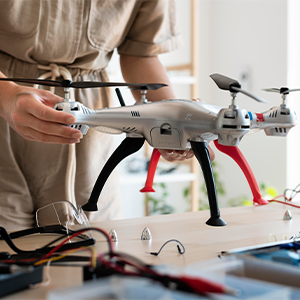Joining the Australian Drone Industry
 Looking to find new exciting career opportunities? The drone industry has exploded over the last several years, offering a wide range of different roles for drone professionals.
Looking to find new exciting career opportunities? The drone industry has exploded over the last several years, offering a wide range of different roles for drone professionals.
A Remote Pilot Licence (RePL) is a licence issued by the Civil Aviation Safety Authority (CASA). This licence permits someone to operate a remotely piloted aircraft (RPA) for a company or in situations that require specialist training. Contrary to popular belief, Australian legislation stipulates that all civilian unmanned aircraft or drones are classified as aircraft. A remote pilot aircraft is an aircraft that is unmanned and controlled by control links and other components associated with the design.
The demand for qualified drone operators (who have their RePL) has surged in recent years and is expected to grow from $9.5 billion to $232 billion by the end of this decade. The industries currently leading in drone usage include agricultural, construction, real estate and telecommunications.
RePL Courses & Training
In Australia, obtaining a remote pilot licence involves a combination of theoretical study and practical flight experience. You must be at least 16 years old, able to read, write, speak, and understand English, and be in a mental and physical condition that allows you to safely operate an unmanned aerial system (UAS).
RePl course training typically takes between 1.5 and 5 days to complete This of course, is dependant on any prior experience and the chosen learning method (such as in-person vs virtual). Most course providers divide the theoretical and practical instruction over the initial days, with the final day (or days) reserved for testing. If weather conditions cause disruptions, the course may take longer to complete. It is common for course providers to also offer a training pack, which includes course notes, access to further training, and additional resources or references.
What Does a RePL Allow
Holding a remote pilot licence and operating a drone enables you to safely and efficiently capture information and imagery, which can then be provided to an organisation or business in need of such data. A remote pilot licence is continuous and does not require renewal.
Once your RePL has been issued by CASA, you are authorised to:
- Fly a drone over your own land for commercial purposes, provided it weighs less than 150 kg.
- Be employed as a remote pilot for yourself or for a business that holds a Remote Operator Certificate (ReOC).
- Operate various types and weights of drones, as long as you are approved in the following categories:
- Less than 7 kg
- Less than 25 kg
- Less than 150 kg
- More than 150 kg
How Much Can Your Earn
As a freelance drone pilot, you could expect to earn between AUD $35 and AUD $150 per hour, with an average rate of AUD $85 per hour. For those employed full-time, hourly earnings typically range from AUD $80 to AUD $120, with a mean rate of AUD $95 per hour. Your exact earnings will vary depending on the industry you work in and your level of experience.
How Drones Are Being Used
There are four main types of drones. These are: Multi-rotor, Single-rotor helicopter, Fixed-wing, and Fixed-wing Hybrid VTOL, each having a diverse range of commercial applications. One common use is for inspections, where drones are employed to access high or difficult-to-reach areas for inspecting roofs, power stations, transmission lines, telecommunication and radio towers, oil and gas assets, and more.
Another significant use is for monitoring and management. Before the advent of drone technology, this was often done manually, requiring considerable time and resources to cover large or hard-to-reach areas. Industries that frequently use drones for this purpose include waste management, agriculture, forestry and traffic control.
On the otherhand, there are a range of industries were drones are used for surveying and aerial mapping. These include, such as mining, landfill sites, building and construction, real estate, architecture and property development, town planning, facilities management.
If you ever considered a career with drones, there has never been a better time to obtain a remote pilot licence. For those who already hold a remote pilot licence, there are opportunities to pursue additional certifications or qualifications, such as aerial surveying. With the growing demand for this skill set and technological advancements, the use of drones is set to become increasingly widespread across various industries, leading to greater employment opportunities.

